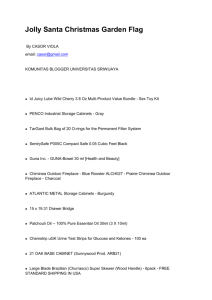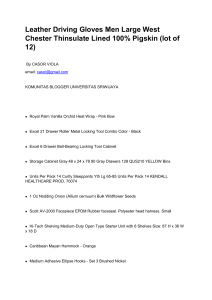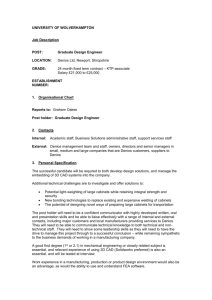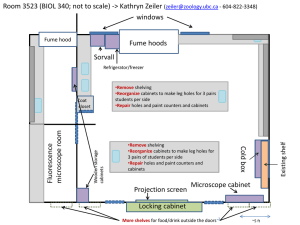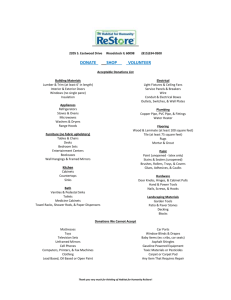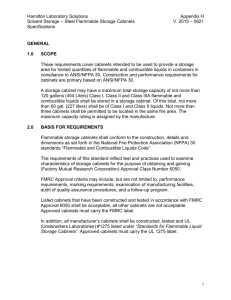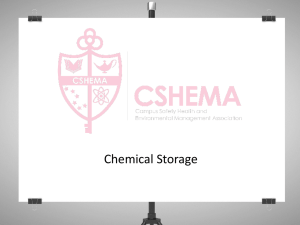18.35 Biological Safety Cabinets
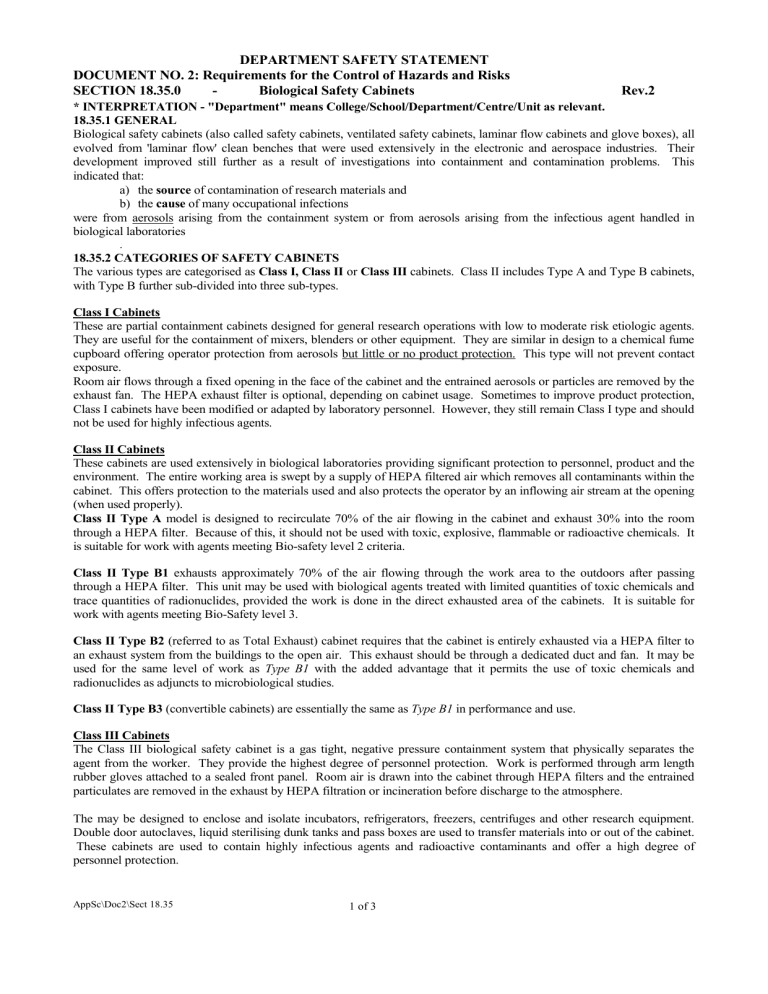
DEPARTMENT SAFETY STATEMENT
DOCUMENT NO. 2: Requirements for the Control of Hazards and Risks
SECTION 18.35.0 - Biological Safety Cabinets Rev.2
* INTERPRETATION - "Department" means College/School/Department/Centre/Unit as relevant.
18.35.1 GENERAL
Biological safety cabinets (also called safety cabinets, ventilated safety cabinets, laminar flow cabinets and glove boxes), all evolved from 'laminar flow' clean benches that were used extensively in the electronic and aerospace industries. Their development improved still further as a result of investigations into containment and contamination problems. This indicated that: a) the source of contamination of research materials and b) the cause of many occupational infections were from aerosols arising from the containment system or from aerosols arising from the infectious agent handled in biological laboratories
.
18.35.2 CATEGORIES OF SAFETY CABINETS
The various types are categorised as Class I, Class II or Class III cabinets. Class II includes Type A and Type B cabinets, with Type B further sub-divided into three sub-types.
Class I Cabinets
These are partial containment cabinets designed for general research operations with low to moderate risk etiologic agents.
They are useful for the containment of mixers, blenders or other equipment. They are similar in design to a chemical fume cupboard offering operator protection from aerosols but little or no product protection. This type will not prevent contact exposure.
Room air flows through a fixed opening in the face of the cabinet and the entrained aerosols or particles are removed by the exhaust fan. The HEPA exhaust filter is optional, depending on cabinet usage. Sometimes to improve product protection,
Class I cabinets have been modified or adapted by laboratory personnel. However, they still remain Class I type and should not be used for highly infectious agents.
Class II Cabinets
These cabinets are used extensively in biological laboratories providing significant protection to personnel, product and the environment. The entire working area is swept by a supply of HEPA filtered air which removes all contaminants within the cabinet. This offers protection to the materials used and also protects the operator by an inflowing air stream at the opening
(when used properly).
Class II Type A model is designed to recirculate 70% of the air flowing in the cabinet and exhaust 30% into the room through a HEPA filter. Because of this, it should not be used with toxic, explosive, flammable or radioactive chemicals. It is suitable for work with agents meeting Bio-safety level 2 criteria.
Class II Type B1 exhausts approximately 70% of the air flowing through the work area to the outdoors after passing through a HEPA filter. This unit may be used with biological agents treated with limited quantities of toxic chemicals and trace quantities of radionuclides, provided the work is done in the direct exhausted area of the cabinets. It is suitable for work with agents meeting Bio-Safety level 3.
Class II Type B2 (referred to as Total Exhaust) cabinet requires that the cabinet is entirely exhausted via a HEPA filter to an exhaust system from the buildings to the open air. This exhaust should be through a dedicated duct and fan. It may be used for the same level of work as Type B1 with the added advantage that it permits the use of toxic chemicals and radionuclides as adjuncts to microbiological studies.
Class II Type B3 (convertible cabinets) are essentially the same as Type B1 in performance and use.
Class III Cabinets
The Class III biological safety cabinet is a gas tight, negative pressure containment system that physically separates the agent from the worker. They provide the highest degree of personnel protection. Work is performed through arm length rubber gloves attached to a sealed front panel. Room air is drawn into the cabinet through HEPA filters and the entrained particulates are removed in the exhaust by HEPA filtration or incineration before discharge to the atmosphere.
The may be designed to enclose and isolate incubators, refrigerators, freezers, centrifuges and other research equipment.
Double door autoclaves, liquid sterilising dunk tanks and pass boxes are used to transfer materials into or out of the cabinet.
These cabinets are used to contain highly infectious agents and radioactive contaminants and offer a high degree of personnel protection.
AppSc\Doc2\Sect 18.35 1 of 3
DOCUMENT NO. 2: Requirements for the Control of Hazards and Risks
SECTION 18.35.0 - Biological Safety Cabinets Rev.2
18.35.3 HAZARDS
The main hazards of biological safety cabinets are related to the nature of the activities involved and the hazard category of the organisms being manipulated. (See also Section 18.36.0 Biological & Biomedical Laboratories ). The hazards may also be associated with the incorrect choice of safety cabinet (for a particular class of biohazard), incorrect use, fan failure, siting and filter blockage.
These hazards have the potential to cause:
Exposure of an operator to infectious agents.
Exposure of other persons to infectious agents.
Exposure of operators and other persons to toxic chemicals, including carcinogens or radioactive materials.
Fire and/or Explosion.
18.35.4 RISKS
The risks associated with the aforementioned hazards are to be assessed by the Department (using the appropriate technical input where necessary). These assessments shall be carried out using:
(i) Check lists provided (where applicable) and
(ii) Departmental Hazard Identification/Risk Assessment Work Sheets contained in Document No.3 i.e. Departmental
Hazard Risk Assessment (D.H.R.A.).
18.35.5 ARRANGEMENTS AND CONTROLS REQUIRED
These hazards and risks will be minimised by the following arrangements and controls:
All users must receive basic safety training in the correct use and operating procedures of cabinets, as well as types of hazards that may be encountered.
Adopting good aseptic practices and safe personal habits.
Appropriate personal protection shall be used to avoid long term, low-level exposure to hazardous substances or allergens.
Wearing the specified personal protective clothing and equipment for the work activities involved.
Written procedures (outlining safe operating techniques) shall be drawn up and rigorously implemented.
All biological laboratory rules in place shall be strictly enforced and reviewed regularly
All safety cabinets shall comply with requirements of latest BS-EN standard for Microbiological Safety Cabinets.
All safety cabinets shall be properly certified to ensure they meet the relevant performance criteria and equipment integrity requirements. This to be undertaken when installed and at regular intervals, with written records kept.
Cabinets shall be located/installed out of traffic areas, away from air movements and doors, (to maximise containment through the avoidance of air turbulence).
The cabinets shall never be used unless the fan is on and the airflow indicator is in the safe position.
The airflow shall be measured regularly (at least annually) and recorded.
If the cabinet has a glass-viewing panel that may be opened, this should not be raised when work is in progress.
On completion of a work session, the working surfaces should be wiped with an approved disinfectant. The wire grids protecting the pre-filters shall be examined regularly and cleaned with a disinfectant soaked cloth.
Ultra-violet (UV) lamps are not effective for disinfecting cabinets. If fitted, they must not be switched on during use of the cabinet, as they may be a safety risk to operators.
Class II Type A cabinets shall not be used with explosive flammable or toxic substances.
Class II Type B1 cabinets shall not be used with explosive flammable substances.
Nothing should be placed on top of Class II type A exhaust grilles.
Safety cabinets shall not be used as storage areas or overloaded with materials, as this will disrupt the airflow pattern.
AppSc\Doc2\Sect 18.35 2 of 3
5.
6.
2.
3.
4.
DOCUMENT NO. 2: Requirements for the Control of Hazards and Risks
SECTION 18.35.0 - Biological Safety Cabinets Rev.2
18.35.5 ARRANGEMENTS AND CONTROLS REQUIRED (contd.)
Bunsen burners or other equipment that would cause air turbulence and loss of containment should not be used in a biological safety cabinet
Cabinets shall be installed out of traffic areas, away from air movements and doors so as to maximise containment.
A strict maintenance system covering airflow measurements, HEPA filter replacement, leaks, noise, vibration, lighting etc. should be put in place at department level.
Cabinets shall be re-certified if they are moved/re-located or after replacing HEPA filters.
The following procedures should be adopted when involved with hazardous substance: a) Turn on the cabinet light, check that the air intake and exhaust grills are not obstructed and purge the cabinet of 'dirty' air by running the fan for at least 5 minutes. b) Ensure hands and arms are sterile by washing with germicidal soap and don laboratory coat, gloves etc. c) Disinfect the interior work surfaces with 70% ethanol in water or recommended disinfectant. Place an absorbent, plastic lined bench paid in the cabinet, taking care not to cover the air grilles at front and rear. d) Place all required materials in the cabinet in such a way that clean items, cultures and receptacles are segregated from contaminated ones. Locate clean pipettes, cultures, flasks etc. not less than 10cm from the front of the cabinet and contaminated discard trays for cultures, plates and other items to the rear of the cabinet. e) N.B. .
Since airflow is downward, do not pass contaminated materials over clean items. (This may be prevented by good work organisation). f) In so far as possible, avoid any interruptions after the work as commenced to minimise loss of containment. g) Ensure the laboratory doors are kept closed during work to prevent disruption of the air stream and loss of containment.
18.35.6 ARRANGEMENTS AND CONTROLS
The details of the Arrangements and Controls in place and those required in the short, medium and long term, shall be set out by the Department in the forms provided in Document No.4 i.e. Departmental Safety Action Plan (D.S.A.P.). These
Arrangements and Controls shall be reviewed and updated on a yearly basis.
18.35.7 RESPONSIBILITIES
The following personnel are responsible in the Dept./Lab/Area for ensuring the implementation and ongoing compliance with the aforementioned arrangements and controls.
AREA/LOCATION PERSON RESPONSIBLE
1.
AppSc\Doc2\Sect 18.35 3 of 3
